About Sidewalk Closed Signs
What are Sidewalk Closed Signs, and how are they used?
Sidewalk Closed Signs inform pedestrians that the usual travel path has been interrupted by construction work. Signs are placed ahead of work zones to create distance between pedestrians and work zone hazards.
What do Sidewalk Closed Signs look like?
Signs are white with black text and a black border. Some signs also include a horizontal directional arrow pointing to the left, to the right, or to both the left and right.
Who uses Sidewalk Closed Signs?
Developers, private utility companies, municipalities, and road work contractors use Sidewalk Closed Signs to temporarily close sidewalks and protect pedestrians from construction or utility hazards.
What other signs are commonly used with Sidewalk Closed Signs?
Black-on-orange Pedestrian Detour Signs (M4-9b) and Pedestrian/Bicyclist Detour Signs (M4-9a) are complementary to Sidewalk Closed Signs and help establish the alternate route for pedestrians to take.
Choosing a Sign
How do I figure out which sign I need?
The two main factors to consider when selecting a sign are where you place the Sidewalk Closed Sign and what alternate travel paths are available. General “Sidewalk Closed” signs have the widest range of use cases, which are listed in Section 6G.10, Paragraph 02 of the MUTCD.
- When an open sidewalk on the other side of the street runs parallel to the closed sidewalk, use a “Sidewalk Closed, (Arrow) Use Other Side” sign. (6G.10, 03)
- “Sidewalk Closed, (Arrow) Cross Here” signs are placed right where pedestrians should cross the road. (6G.10, 05
- Use a “Sidewalk Closed Ahead, (Arrow) Cross Here” sign to direct pedestrians toward “open crosswalks, sidewalks, or other travel paths.” (6G.10, 04)
Should I choose the high-intensity prismatic sheeting or the full-cube prismatic sheeting?
High-intensity prismatic sheeting is the standard choice in most municipalities. Full-cube prismatic sheeting increases the retroreflectivity of the sign and may be required by your local jurisdiction.
Customizations
What sign customizations do you offer?
We offer custom messaging on all of our Sidewalk Closed Signs. One commonly requested customization is specifying the alternate route location. For instance, when a sidewalk closure blocks the main entrance of a parking deck, custom sign messaging can read “Sidewalk Closed, Use Side Entrance”.
Why is my customized sign larger than the standard Sidewalk Closed Sign?
Adding more messaging to the sign often means we size up the sign to match. Larger signs are able to better accommodate custom messaging. Sometimes, signs are 24”x18”, 30”x24”, or larger, depending on the messaging.
Mounting Signs
What mounting options are there for Sidewalk Closed Signs?
Choosing a mount for a Sidewalk Closed Sign depends on your project needs. The MUTCD mentions that Sidewalk Closed Signs are “typically mounted on a detectable barricade” to more visibly communicate that a sidewalk is closed (6G.10, 06). All Sidewalk Closed Signs arrive with 2 pre-punched mounting holes for easy installation.
- The small footprint of Type 1 and Type 2 Barricades makes them a common sign mounting choice.
- Because of their larger size, Type 3 Barricades command more attention and more completely block the path into a work zone.
- Using a round, square, or U-channel sign post is essential when a Sidewalk Closed Sign needs to be placed higher for additional visibility.
- When a chain link fence surrounds a work zone, use our chain link sign installation bracket to mount a Sidewalk Closed Sign.
- Sidewalk Closed Signs can be mounted onto Pedestrian Channelizing Devices
What hardware do I need to mount a Sidewalk Closed Sign?
All the nuts and bolts you need for sign installation can be found on our sign mounting hardware page.
Materials, Standards, and Specifications
What materials are Sidewalk Closed Signs manufactured with?
We use .080” rustproof aluminum for our signs, and we use your choice of high-intensity prismatic or full-cube prismatic retroreflective sheeting to print sign information onto.
Are the signs graffiti-resistant?
Yes, we can layer an optional anti-graffiti laminate film over all Sidewalk Closed Signs. This lamination protects the face of the sign from graffiti, makes the sign surface easy to clean, and improves the sign's durability.
How durable is a Sidewalk Closed Sign?
The primary factor determining sign durability is the reflective sheeting material you select. Signs with high-intensity prismatic sheeting come with a 10-year warranty, and signs manufactured with full-cube prismatic sheeting come with a 12-year warranty. In addition, the optional anti-graffiti film that we use extends the sign’s usable lifetime. When the film is layered onto high-intensity prismatic sheeting, signs have a 12-year warranty. When anti-graffiti film is layered onto full-cube prismatic sheeting, signs have a 15-year warranty.
Orders & Shipping
When will my order arrive?
We aim to ship both standard and customized Sidewalk Closed Signs within XX business days. Check out our reviews written by satisfied customers over the years.
How are Sidewalk Closed Signs packaged for shipping?
To reduce the potential for shipping damage, we place protective slip sheeting on the face of each sign.
More Information
Where can I find more information about these signs?
Chapter 6G, Section 6G.10 of the MUTCD goes into greater detail about Sidewalk Closed Signs.
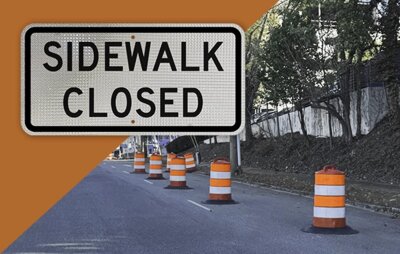
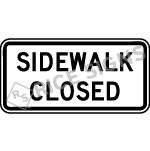 MUTCD R9-9
MUTCD R9-9 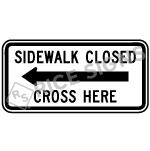 MUTCD R9-11AL
MUTCD R9-11AL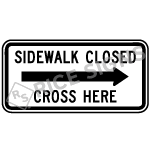 MUTCD R9-11AR
MUTCD R9-11AR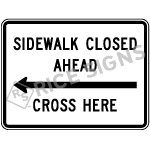 MUTCD R9-11L
MUTCD R9-11L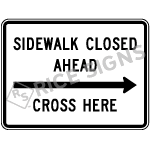 MUTCD R9-11R
MUTCD R9-11R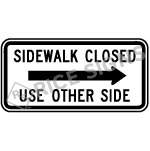 MUTCD R9-10R
MUTCD R9-10R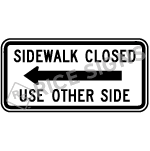 MUTCD R9-10L
MUTCD R9-10L